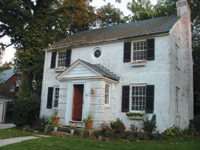
Trading Spaces: International Home Exchange
by Stephanie Citron
 For their summer vacation in 2004, Dan and Joanne Timmel were looking for a different sort of family getaway. Experienced travelers, theywanted to escape their suburban Hunt Valley existence and immerse themselves and their two teenage children in a different culture. While browsing the Internet, Joanne stumbled across a Web site, www.HomeExchange.com, that lists people across the world who are interested in trading houses.
For their summer vacation in 2004, Dan and Joanne Timmel were looking for a different sort of family getaway. Experienced travelers, theywanted to escape their suburban Hunt Valley existence and immerse themselves and their two teenage children in a different culture. While browsing the Internet, Joanne stumbled across a Web site, www.HomeExchange.com, that lists people across the world who are interested in trading houses.
Soon afterward, the Timmels listed their circa-1845 historic home on the Web site and after fielding a number of inquiries from potential home swappers in places like Austria and Wales, they scored a match with a family in England’s Cotswolds, a region that has remained largely unchanged since the 16th and 17th centuries. The white stone house was 2 1/2 stories and had five bedrooms, two enormous fireplaces and a brand-new kitchen. An added bonus was that the 100-mile-long Cotswold Way National Trail skirted the property.
After a succession of friendly e-mails, the telephone calls began. By that time, the Timmels already knew the she in the other house was a lawyer, and he was a general contractor. Their kids were in grade school. The two families exchanged more photos of their respective homes. “We thought we lived in an old home until we learned that part of theirs was constructed in the 1200s,” Dan says. Soon, travel arrangements were made, tickets secured and house- and car-exchange documents were signed.
Before long, the Timmels were exploring the village’s ancient footpaths and spending hours scouring the traditional specialty shops for ingredients for dinner. The neighbors adopted them, inviting them to meals and community events. In Maryland, meanwhile, their exchange family was in ecstasy over the conveniences of American life, especially the 10-minute minivan ride to shop in Hunt Valley. “In the Cotswolds, they have to drive 45 minutes to a movie, a shopping mall or a large grocery store,” Dan Timmel says. “We called each other on the second day to thank each other for trading lives.”
W ith the U.S. dollar taking a beating around the world, rising hotel rates, prohibitive new travel taxes— and the beckoning Internet with its visual, mapping and connection capabilities— adventurous travelers are increasingly opting for the comforts of home (someone else’s) while on vacation. It is arguably the best way to fully assimilate into another culture— and the digs are free.
ith the U.S. dollar taking a beating around the world, rising hotel rates, prohibitive new travel taxes— and the beckoning Internet with its visual, mapping and connection capabilities— adventurous travelers are increasingly opting for the comforts of home (someone else’s) while on vacation. It is arguably the best way to fully assimilate into another culture— and the digs are free.
Here’s how it works: Swapping your home generally requires membership in a home exchange Web site.(See below for recommendations.) After paying the annual fee, which typically ranges from $45 to $100, and posting a listing of your home, you are free to contact any member to make further inquiries. Some sites allow non-members e-mail access to its members, but you are limited to the communications you initiate, and the other members don’t perceive you as part of their home exchange community. The best sites post exchange tips and guidelines, and downloadable home- and car-exchange agreements. Flexibility about dates and destinations are key to successful swaps, and many listers post “Open” or “Surprise Us” in their destination request.
So what should you look for in a home exchange Web site? “Quantity, geographical distribution, ease of finding the lists, the presentation of the listings and that photos are required,” suggests Ed Kushings, founder of HomeExchange.com. His site, one of the largest on the Web with more than 14,000 paid listings, was featured in the recent movie, “The Holiday,” in which two fetching women on opposite sides of the ocean trade spaces to get away from failed romances and find relationships by taking up each other’s lives. Kushings admits that the story line is a bit romanticized, but says the movie “does effectively depict the very real opportunity to become immersed into another culture.”
Helen Bergstein, founder of the online home swap web site Digsville.com, agrees. Home swapping is about living among the locals, shopping in their markets, eating in their restaurants, becoming absorbed in the flavors and rhythm of their region, she says. “It’s the friends you meet along the way that makes home exchange a richer way to travel.”
Bergstein notes that effective home exchange sites “should provide details about the accommodations, the geographical area, what is included in the rental [car, bicycles, pet care and housekeeping] and information about the exchange family.” Digsville is a relative newbie online with a cult following among affluent, urban Gen Xers.
 If the idea of lending your home to a stranger is daunting, veteran swappers proclaim that there is so much back and forth communication between the exchanging parties that everyone feels very familiar by the time the swap actually happens. “It’s like online dating,” explains Chris Kraft, who exchanged his Roland Park home last August for a condo in Barcelona, Spain. “You’re each saying, ‘Who are you? What’s your city? What’s your place like?’ until you’ve garnered enough information to ‘commit.’”
If the idea of lending your home to a stranger is daunting, veteran swappers proclaim that there is so much back and forth communication between the exchanging parties that everyone feels very familiar by the time the swap actually happens. “It’s like online dating,” explains Chris Kraft, who exchanged his Roland Park home last August for a condo in Barcelona, Spain. “You’re each saying, ‘Who are you? What’s your city? What’s your place like?’ until you’ve garnered enough information to ‘commit.’”
Rather than mail keys or exchange them harriedly at an airport, Amanda Conn of Mount Washington hosted her Danish exchange family for two days before she left for their home in Denmark. It provided the families time to get acquainted and exchange travel ideas. Conn selected this particular exchange over more exotic destinations in Europe because the home of a family of seven would surely have toys and friendly bedrooms for her children. It even had a swing set, and was near Legoland. Though it was in a suburb, they were near enough to return home easily between city sightseeing excursions for naps and dinner. “Cooking became critical when we learned in the first two days that peanut butter just doesn’t exist in Denmark,” she says.
Soon after her husband, Howard, retired, Alice Gamse noticed an advertisement for HomeLinkUSA. Intrigued, she ordered a catalog (the pre-Internet index for home swappers) and promptly found herself listing her own beautiful art-filled Mount Washington house and describing mid-Atlantic attractions. Since, then, the Gamses have visited Bavaria, southern France, Britain and spots around the United States. But for them, it is as much about the people behind the listing, as it is about the location. A painter and art collector, Alice delights in the collections and embellishments in the homes she borrows. “We often leave each other notes about the artwork we admire in each other’s homes.”
The Bavarian family met them at the airport and hosted them for a meal before departing for Baltimore, and arranged for their townspeople to do the same. Their college-aged English-speaking daughter stayed behind, and spent afternoons chatting with Alice about the region, literature and art. The Gamses have established a friendship with an American exchange partner and often vacation together. Now that the Gamses have downsized, they swap their new residence— a sprawling sunny condo in Guilford.
It’s easy to see the swap appeal of such places as New York and San Francisco or beachfront property, but do people really want to come to Baltimore? “I wasn’t surprised,” says Dan Timmel. “We live near such historic sites here in the mid -Atlantic. Europeans love history. They love beautiful scenery, and Baltimore is just gorgeous, between the Chesapeake and Western Maryland. And we are so centrally located between New York and D.C.” And some people exchange for occasions: weddings, family visits, proximity to institutions like Johns Hopkins.
Last August Kraft, a professor at Johns Hopkins, knew he’d made a good match because he and his Barcelona counterpart had common perspectives: both were academic professors. This made Kraft comfortable leaving his BMW in their hands; when he learned that they had just purchased a new Renault, he thought, “Score!” Once in Barcelona, Kraft found himself in a modern condo near center city, easy to navigate by car or on the bicycles his home exchanger had left for him.
Still a rookie at swapping, Kraft has learned some lessons, however. He was traveling with three friends on his adventure and when they arrived in Barcelona they found the second bedroom outfitted with kid-size beds. The owner’s mother, who lived a few floors above, was available to provide help— but only in Spanish. And they had shut down their Internet connection, so he spent unanticipated time (and money) in an Internet café. Next time he’ll ask more questions and request more pictures.
Home exchanges are not for everyone. There are occasional complaints, like broken plates, excessive phone bills and rewired electronics. “You have to get over that people are going to be touching your stuff,” says Kraft. Largely, though, exchange site principals report that complaints are uncommon. In rare instances where an exchanging family changes its mind at the last minute, the organization steps in and finds another location (perhaps a good reason to select a site with a large paid membership).
Ultimately, the concept succeeds because of mutual trust and goodwill. Surveys done by Digsville.com’s Bergstein indicate that home swappers tend to be prosperous, educated, entrepreneurial people who care about their homes and will care about yours.
After all, they are lending their most valuable asset and are using yours. Dan Timmel puts it this way: “Sure I was a little uneasy about a stranger among my things, but once I got to his house, I realized I had all of his collateral under my nose, too.”
Freelance writer Stephanie Citron plans on swapping her family’s Park City, Utah, vacation condo with a stunning house overlooking the ocean in Sydney, Australia, for Christmas 2007.
Many Web sites offer home exchange listings. Those listed below have worldwide listings, are updated annually and have longevity in the trade. There are many niche exchange sites that may be found by searching via the appropriate phrase (senior, Christian, disabled, gay, etc).
>Digsville, http://www.digsville.com. Site allows members to set up a personal home page and blog. Only members may post listings. Users claim references are particularly valuable on this site because Digsville permits feedback without pre-screening from the exchangers whose home is rated. About 4,000 listings. $44.95 annually.
>HomeExchange.com, http://www.homeexchange.com. Web-only organization with 14,000 members worldwide. Owner is active and dedicated to customer service and his progressive user-friendly Web site. Bronze Membership includes listing and unlimited inquiries, $59.95; Silver Membership includes unlimited inquiries, but no listing, $25.
>HomeLink USA, http://www.homelink.org. One of the largest home exchange organizations worldwide, with 14,000-plus members in 60 countries. Only members can access contact information. Full membership: $140 includes annual Web access to listings and three printed directories; $90 per year for Web-only membership.
>Intervac, http://www.intervacUS.com. World’s oldest home exchange organization, founded 1952; about 12,000 listings, mostly outside the United States. Only members can access contact information. Listings: $65 annually for Web membership, $125 for Web plus printed directories.
>International Home Exchange Network, http://www.ihen.com. Company won’t disclose its paid listings but membership is represented in more than 60 countries, and it claims 350,000 home inquiries take place each month. $39.95 annually for Web listing. Non-members may contact members for free.
Copyright @ 2016, Baltimore Style
